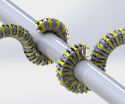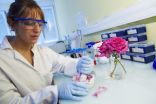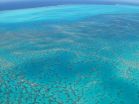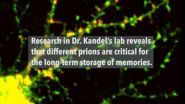Why the seahorse's tail is square
And how it could be an inspiration for robots and medical devices
2015-07-02
(Press-News.org) Why is the seahorse's tail square? An international team of researchers has found the answer and it could lead to building better robots and medical devices. In a nutshell, a tail made of square, overlapping segments makes for better armor than a cylindrical tail. It's also better at gripping and grasping. Researchers describe their findings in the July 3 issue of Science.
"Almost all animal tails have circular or oval cross-sections--but not the seahorse's. We wondered why," said Michael Porter, an assistant professor in mechanical engineering at Clemson University and the lead investigator on the study, who earned his Ph.D. in materials science and engineering at the University of California, San Diego, in 2014. "We found that the squared-shaped tails are better when both grasping and armor are needed."
Also remarkable, the square plates make the seahorse's tail stiffer, stronger and more resistant to strain at the same time. Usually, strengthening any one of these characteristics will weaken at least one of the others, Porter said. He and colleagues set out to find out why.
They found that square plates move with only one degree of freedom when crushed: they slide. By contrast, circular plates have two degrees of freedom: they slide and they rotate. As a result, the square plates absorb much more energy before permanent failure begins.
To arrive at their findings, researchers used a wide range of techniques, including 3D-printing a simplified model of the seahorse's tail, which they then bent, twisted, compressed and crushed. They also 3D-printed and ran similar experiments on a tail model made of overlapping round segments that they designed and that is not found in nature.
"New technologies, like 3D-printing, allow us to mimic biological designs, but also build hypothetical models of designs not found in nature," said Porter "We can then test them against each other to find inspiration for new engineering applications and also explain why biological systems may have evolved."
The Science study builds on work Porter started at UC San Diego in collaboration with Dominique Adriaens, professor of evolutionary biology at Ghent University and UC San Diego materials science and engineering professors Joanna McKittrick and Marc Meyers. "Michael decided to use engineering and technology to explain biological features," said McKittrick, who was Porter's co-advisor and is a co-author on the paper. You can simplify nature and study it in the lab, added Meyers, also a co-author and Porter co-advisor. "Then you can build new bioinspired structures and devices."
Porter's research group at Clemson is now applying this method to develop new structures and robotic systems that mimic a variety of other natural--and hypothetical--systems, allowing him to translate his research across disciplines: from biology as a source of inspiration for engineering; and from engineering as a tool for the exploration of biology.
Grasping, gripping
When researchers twisted the 3D-printed square seahorse tail model, they found that its plates interfered with one another, limiting its range of movement by about half when compared to the model made of round segments. In addition, after it was twisted, the square model returned to its original shape faster, while expending a minimum amount of energy. Researchers theorize this might protect the tail from damage. By contrast, a tail made from round segments twists easily and requires more energy to return to its original shape. Researchers also found that the tail's square segments created more contact points with the surface that it is gripping when compared to a tail with round segments.
In addition, a seahorse's tail bends in a way that allows it to grasp objects within its line of sight. Study co-author Ross L. Hatton, assistant professor of mechanical engineering at Oregon State University and specialist in robotics, helped Porter develop geometric models describing the tail's mechanics and proving its geometry is optimized precisely for this kind of grasping.
Armor
Researchers also compressed the models made of 3D-printed segments and compared their behavior to 3D-printed solid structures with square and circular cross-sections--but without segments. They found that a seahorse's tail has joints at the exact locations where the solid structures fail when crushed. This allows the structures to absorb more energy on impact. Even more impressive, the square model outperformed the round one in all crushing tests. This is because square segments fail without changing their general shape. By contrast, round segments open up under the applied load, changing their shape from circular to elliptical.
This is important, because water birds are one of the seahorse's main predators and capture their prey with their beaks and crush them in the process.
Applications
Porter is also investigating how devices inspired by the structure of the seahorse's tail could be used in real life. One possibility is to scale up the structure to build a gripping robotic arm that can be used in hostile environments. Another is to scale it down to build a catheter. But the possibilities are many, said study co-author Meyers.
Structure of the seahorse's tail
The seahorse's tail is typically made up of about 36 square-like segments, each composed of four L-shaped corner plates that progressively decrease in size along the length of the tail. The plates are free to glide or pivot. Gliding joints allow the bony plates to slide past one another. Pivoting joints are similar to ball-and-socket joints, with three degrees of rotational freedom. The plates are connected to the vertebrae by thick collagen layers of connective tissue. The joints between plates and vertebrae are extremely flexible with nearly six degrees of freedom.
INFORMATION:
The research was funded by the Air Force Office of Scientific Research, the National Science Foundation, the Belgian Agency for Innovation by Science and Technology, Oregon State University and Clemson University.
Videos and stils available here: http://bit.ly/1QZUquo (Dropbox)
Paper reference (after embargo lifts) http://www.sciencemag.org/lookup/doi/10.1126/science.aaa6683
ELSE PRESS RELEASES FROM THIS DATE:
2015-07-02
This news release is available in Japanese. Researchers working with roses have identified an enzyme, known as RhNUDX1, which plays a key role in producing the flowers' sweet fragrances. These ornamental plants, which provide essential oils for perfumes and cosmetics, have been bred mostly for their visual traits, and their once-strong scents have faded over the generations. Restoring their fragrant odors will require a better understanding of the rose scent biosynthesis pathway. Until now, most studies of rose fragrance have focused on a biosynthetic pathway that generates ...
2015-07-02
This news release is available in Japanese. The seahorse tail is square because this shape is better at resisting damage and at grasping than a circular tail would be, a new engineering study shows. Insights gleaned from the study could inspire new armor and advances in robotics, the authors say. While most animals with tails, including certain monkeys, lizards and rodents, have soft, cylindrical-shaped appendages, tails of seahorses are organized into square prisms surrounded by bony plates. To better understand why the seahorse tail deviates from the norm, and what ...
2015-07-02
Mass killings and school shootings in the U.S. appear to be contagious, according to a team of scientists from Arizona State University and Northeastern Illinois University.
Study author Sherry Towers, research professor in the ASU Simon A. Levin Mathematical, Computational and Modeling Sciences Center, explained, "The hallmark of contagion is observing patterns of many events that are bunched in time, rather than occurring randomly in time."
Her team examined databases on past high-profile mass killings and school shootings in the U.S. and fit a contagion model to ...
2015-07-02
Climate change is forcing fish out of their current habitats and into cooler waters and many more species will soon be affected if climate goals are not met, say scientists.
An international team of researchers compared the future of the oceans under two climate change scenarios. In one scenario, we limit atmospheric warming to two degrees by 2100, as outlined by the Copenhagen accord. In the other, we continue with the current approach, which researchers say would cause a five-degree increase in atmospheric temperatures. They say if warming continues unchecked, fish ...
2015-07-02
A new study has discovered mysterious behaviour of a material that acts like an insulator in certain measurements, but simultaneously acts like a conductor in others. In an insulator, electrons are largely stuck in one place, while in a conductor, the electrons flow freely. The results, published today (2 July) in the journal Science, challenge current understanding of how materials behave.
Conductors, such as metals, conduct electricity, while insulators, such as rubber or glass, prevent or block the flow of electricity. But by tracing the path that electrons follow ...
2015-07-02
Researchers at Vanderbilt University and the National University of Singapore have determined the structure of a human monoclonal antibody which, in an animal model, strongly neutralizes a type of the potentially lethal dengue virus.
The finding, reported today July 2 in the journal Science, could lead to the first effective therapies and vaccines against dengue, a complex of four distinct but related mosquito-borne viruses that infect about 390 million people a year and which are a leading cause of illness and death in the tropics.
"Scientists in the antibody discovery ...
2015-07-02
NEW BRUNSWICK, N.J., - July, 2, 2015 - Johnson & Johnson (NYSE: JNJ) announced today that scientists at Beth Israel Deaconess Medical Center (BIDMC), Crucell Holland B.V, one of the Janssen Pharmaceutical Companies of Johnson & Johnson (Janssen), and several other collaborators today published results from a preclinical study of an HIV vaccine regimen used in in non-human primates. The study, published in the online edition of Science, suggests that a "heterologous prime-boost" vaccine regimen--which first primes the immune system, then boosts the immune system to increase ...
2015-07-02
Doughnuts, electric current and quantum physics - this will sound like a weird list of words to most people, but for Sebastian Huber it is a job description. ETH-professor Huber is a theoretical physicist who, for several years now, has focused his attention on so-called topological insulators, i.e., materials whose ability to conduct electric current originates in their topology.
The easiest way to understand what "topological" means in this context is to imagine how a doughnut can be turned into a coffee cup by pulling, stretching and moulding - but without cutting ...
2015-07-02
Hamilton, ON (July 2, 2015) - Two new studies led by researchers from the Farncombe Family Digestive Health Research Institute at McMaster University show that transplantation of fecal matter may be a useful tool in the fight against ulcerative colitis (UC).
Ulcerative colitis is a chronic, debilitating inflammatory bowel condition characterized by symptoms including bloody stools, diarrhea, abdominal pain, weight loss and malnutrition. It results from the development of abnormal immune responses to the normal bacteria in the digestive tract. It is difficult to treat ...
2015-07-02
NEW YORK, NY (July 2, 2015)--Research from Eric Kandel's lab at Columbia University Medical Center (CUMC) has uncovered further evidence of a system in the brain that persistently maintains memories for long periods of time. And paradoxically, it works in the same way as mechanisms that cause mad cow disease, kuru, and other degenerative brain diseases.
In four papers published in Neuron and Cell Reports, Dr. Kandel's laboratory show how prion-like proteins - similar to the prions behind mad cow disease in cattle and Creutzfeld-Jakob disease in humans - are critical ...
LAST 30 PRESS RELEASES:
[Press-News.org] Why the seahorse's tail is square
And how it could be an inspiration for robots and medical devices







